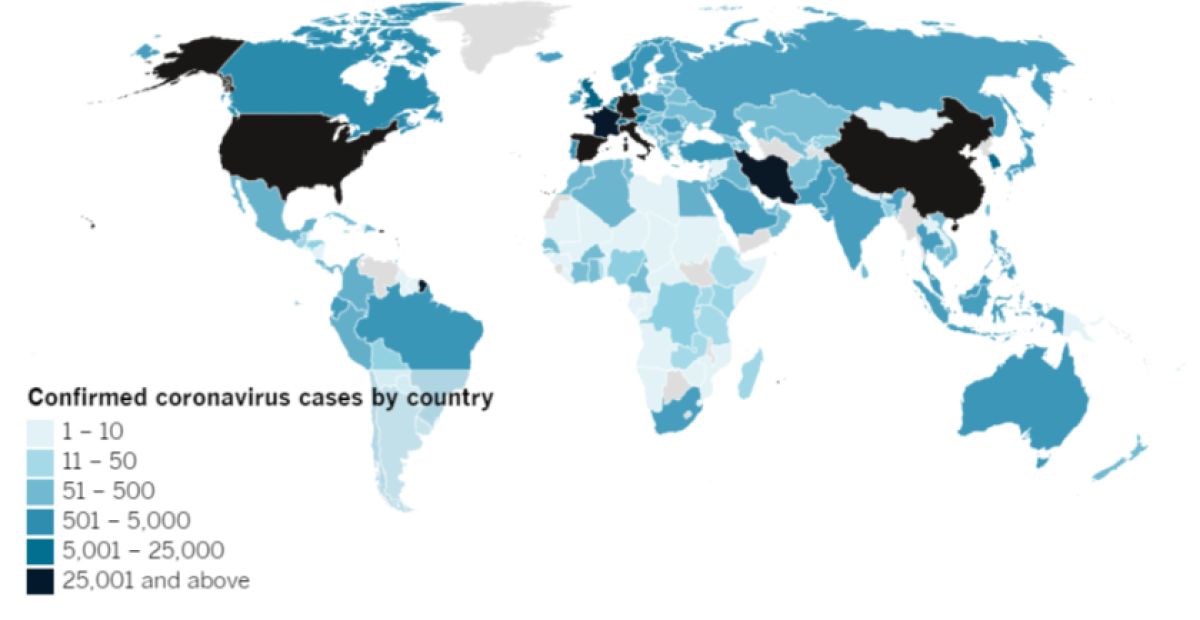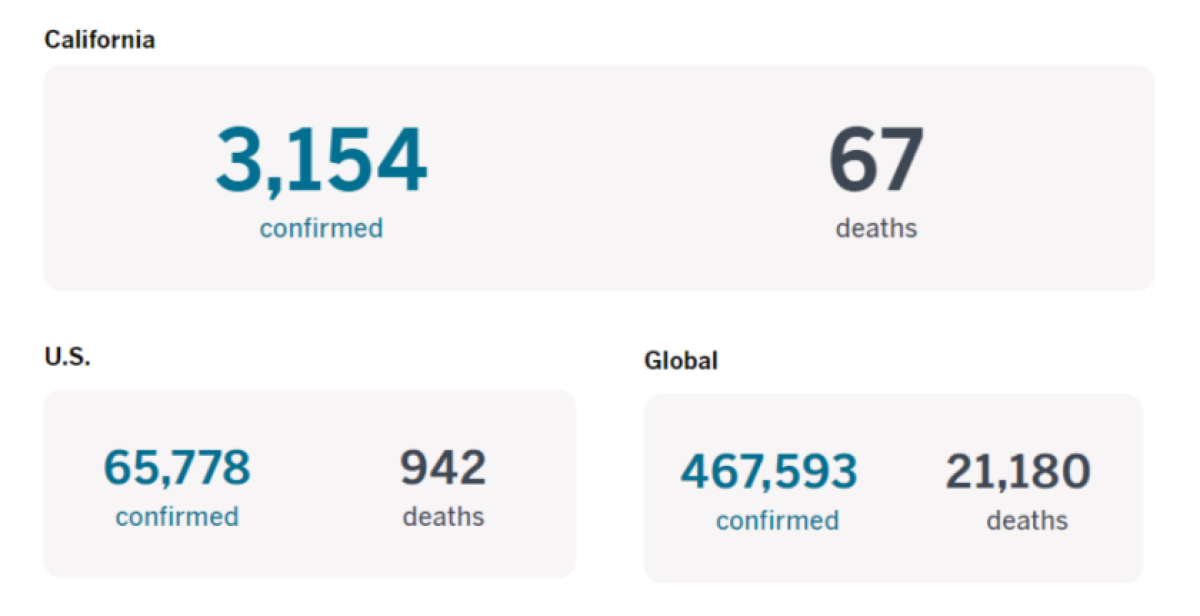Coronavirus Today: A $2-trillion economic jump-start
- Share via
Good evening. I’m Diya Chacko, and it’s Wednesday, March 25. Here’s what’s happening with the coronavirus outbreak in California, in Washington and beyond.
The Senate has passed a $2-trillion economic stimulus package — the largest ever — in order to pump money directly into Americans’ pockets and shore up struggling hospitals, businesses and state and local governments. President Trump has vowed to sign it when it reaches his desk, and with passage expected in the House on Friday, many Americans could see one-time payments as soon as early April.
Individuals who make $75,000 or less and married couples making up to $150,000 would receive $1,200 per adult and $500 per child. Individuals making up to $99,000 and couples making up to $198,000 would receive lower amounts, and people whose incomes are higher than that would not receive a check. (Income levels will be based on reported 2018 taxes.) The package would also expand unemployment insurance eligibility and extend its benefits.
Los Angeles Mayor Eric Garcetti said Wednesday evening that area agencies could receive more than $1 billion in aid as part of the legislation. “I can hardly look at this as a stimulus package; it’s a survival package,” he told reporters.
Also in California, a mortgage-relief package negotiated with several major banks and financial institutions will let eligible homeowners defer mortgage payments for at least three months and perhaps longer if they suffer economic hardship due to the pandemic. Any late payments would not be reported to credit agencies.
But unlike some other states, California has not implemented a statewide ban on evictions. Nor has it offered a comprehensive deferral of rent payments — even though millions of Californians are renters.
More than 1 million Californians have applied for unemployment benefits this month after being laid off or having their work hours reduced, said Gov. Gavin Newsom. Need to apply for benefits? Here’s where to begin.
Public health authorities suspect that tens of thousands of Americans, if not more, have had COVID-19 without realizing it because they suffered few or very mild symptoms. Identifying those who are no longer sick may not seem as urgent as testing those who may be newly infected. But it’s possible that recovered patients, whose immune systems have a track record of defeating the coronavirus, could provide care and even a cure for those who are sick. And if they could be tested and counted, their numbers would offer a barometer of how near we are to this pandemic’s end.
By the numbers
Cases as of 8 p.m. PDT Wednesday:
Track the latest numbers and how they break down by county and by state with our graphics.
Where is the coronavirus spreading?

Your support helps us deliver the news that matters most.
Across California
Confirmed cases of COVID-19 continue to double in the state every three to four days, a fast pace on par with New York, where some hospitals are overwhelmed and nearly 200 people have died. “We originally thought that it would be doubling every six to seven days,” said Dr. Mark Ghaly, California’s secretary of health and human services.
Health officials have hinted that it’s possible that California’s coronavirus crisis may come to resemble Italy’s. An uneven public health response there and the inability to carry out widespread testing have driven Italy’s death toll to more than double that of China, despite the fact that China’s population is 23 times larger.
In Los Angeles County, a severe shortage of protective gear prompted officials to advise doctors and nurses Wednesday to reuse face masks and wear gowns and masks that are expired, a desperate bid to conserve supplies with infections rapidly rising. In San Jose, about half of Kaiser Permanente’s hospital has been filled with patients confirmed or suspected to have the coronavirus, as Silicon Valley has emerged the epicenter of the state’s crisis.
To clear space for the expected wave of COVID-19 victims, hospitals are desperately trying to discharge elderly patients who have recovered from various ailments. But nursing homes are reluctant to accept any new patients — or even returning residents — until they can prove they are free of the virus. That’s leaving some seniors stranded in in-demand hospital rooms.
Students with disabilities and their parents are suffering under California’s school shutdown. Overnight, the intense hands-on assistance the children require for their educational and physical needs is gone. In many cases, online learning efforts won’t meet their needs.
Despite rumors to the contrary, the Los Angeles Police Department says its officers are not citing people for violating the city’s strict Safer at Home restrictions. “No, the LAPD is not stopping or ticketing people for exercising outdoors,” the department announced on Twitter. “Spreading false rumors during this time does no good.”
How to stay safe
— Wash your hands for at least 20 seconds! Here’s a super-fun how-to video.
— Stop touching your face, and keep your phone clean.
— Watch for symptoms including fever, cough and shortness of breath (and possibly the loss of smell or taste), and if you’re worried you might be infected, call your doctor or urgent care clinic before going.
— Practice social distancing, such as maintaining a 6-foot radius of personal space in public.
— Only wear a mask if circumstances warrant it, for instance if you must be in very close contact with people in public.
— Here’s how to care for someone with COVID-19, from monitoring their symptoms to preventing the virus’ spread.
How to stay sane
— Was your job affected by coronavirus? Here’s how to file for unemployment.
— Here are all the ways to stay virtually connected with your friends.
— Need groceries? Here’s how to stock up for staying home. You can also watch our video guide on YouTube.
— Visit our free games and puzzles page for daily crosswords, card games, arcade games and more.
— Here are some free resources for restaurant workers and entertainment industry professionals having trouble making ends meet.
— Advice for helping kids navigate pandemic life includes being honest about uncertainties, acknowledging their feelings and sticking to a routine. Here’s guidance from the CDC.
— The L.A. Times Book Club will meet virtually beginning Monday and chat with L.A. noir authors. For more information, sign up for its newsletter.
Around the nation and the world
New York Gov. Andrew Cuomo says the number of people hospitalized with COVID-19 in the state has climbed to 3,800, with close to 900 in intensive care. A makeshift morgue has been set up outside Bellevue Hospital, and the city’s police, their ranks dwindling as more fall ill, were told to patrol nearly empty streets to enforce social distancing.
The coronavirus is spreading fast in Louisiana, with 1,388 cases and 46 deaths. Despite a statewide stay-at-home order, the Rev. Tony Spell held Pentecostal services in Baton Rouge that drew 1,800 people last Sunday. The services pose a unique challenge, pitting the constitutional right to the free expression of religion against legitimate government efforts to protect public health.
Doctors and nurses at public hospitals in Mexico have begun protesting a shortage of personnel and basic supplies such as masks and gloves, with staff holding strikes and walkouts across the country this week. “We feel unprotected,” one doctor said, amid growing concerns that the government has moved too slowly to fight the disease.
Countries around the world have moved far more aggressively to counter the coronavirus than they have to address the climate crisis. But some scientists wonder if the unprecedented global mobilization to slow the pandemic might help pave the way for more dramatic climate action. For instance, the government’s willingness to provide financial relief for the most vulnerable, and a shift in the public’s attitude toward protecting the collective instead of acting in self-interest, could set a precedent for more aggressive movement to mitigate climate change, experts said.
Your questions answered
Today’s reader question comes from Randy Silva, who wants to know: What are the chances of contracting the coronavirus using public transportation? Reporter Laura J. Nelson spoke to the L.A. Metropolitan Transportation Authority to find out more.
It is possible to contract the coronavirus when using public transportation, as buses and trains are shared public spaces with many surfaces that multiple people touch.
While the L.A. Metro does not plan to shut down — the system is a lifeline for people who still need to commute to essential jobs, take care of relatives, go to medical appointments and run errands — vehicles are being cleaned daily, representatives said. Crews have strengthened their cleanings of areas that riders are most likely to touch, like handrails, ticketing machines, seats, escalator rails and elevator buttons.
If you must take public transit, experts recommend keeping a 6-foot distance from other people (which is often tricky on buses and trains, but perhaps less so now that fewer people are commuting) and washing or sanitizing your hands as soon as you’ve arrived at your destination.
Got a question? Our reporters covering the coronavirus outbreak want to hear from you. Email us your questions, and we’ll do our best to answer them. You can find answers to other common questions in our morning and midday roundup.
For the most up-to-date coronavirus coverage from The Times, visit our live updates page, visit our Health section and follow us on Twitter and on Instagram.





